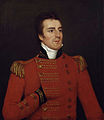藏手禮
外觀

藏手禮(英語:hand-in-waistcoat;法語:main dans le gilet)是在18至19世紀的西方肖像畫中十分常見的一種姿勢。1750年代之前藏手禮便已出現於肖像畫中,用以表現沉穩、堅定的領袖氣質。藏手禮經常與拿破崙聯繫在一起,這是由於法國畫家雅克-路易·大衛為拿破崙所繪的多幅肖像中均出現了這一動作,其中包括1812年的作品《拿破崙在書房》(Napoleon in His Study)。此後,許多西方肖像畫家都在作品中借鑑了這種姿態,後又見於19世紀中期的一些攝影作品中。[1]
藏手禮最早可以追溯到古希臘演說家埃斯基涅斯。他認為,演講時將手露出長袍是一種不當的行為。[2]阿琳·邁耶(Arline Meyer)在其《為古典雕像重新穿衣:十八世紀的「藏手禮」肖像》(Re-Dressing Classical Statuary: The Eighteenth-Century 'Hand-in-Waistcoat' Portrait)一文中指出,18世紀英國肖像畫中的藏手禮是用來表現被畫者的良好教養的。弗朗索瓦·尼弗隆(Francois Nivelon)則在其1738年出版的《溫雅舉止之書》(A Book Of Genteel Behavior)中認為藏手禮體現了一種帶着些謙遜的男子氣概。[2]
藏手禮圖集
[編輯]參考文獻
[編輯]- ^ Uwe Fleckner, "Napoleons Hand in der Weste: von der ethischen zur politischen Rhetorik einer Geste' ['Napoleon's hand in the waistcoat: from the ethical to the political rhetoric of a gesture'] Daidalos 64 (June 1997), 122-29
- ^ 2.0 2.1 Holmberg, Tom. Why is Napoleon depicted with his hand in his coat?. The Napoleon Series. [2008-08-26]. (原始內容存檔於2021-04-16).













